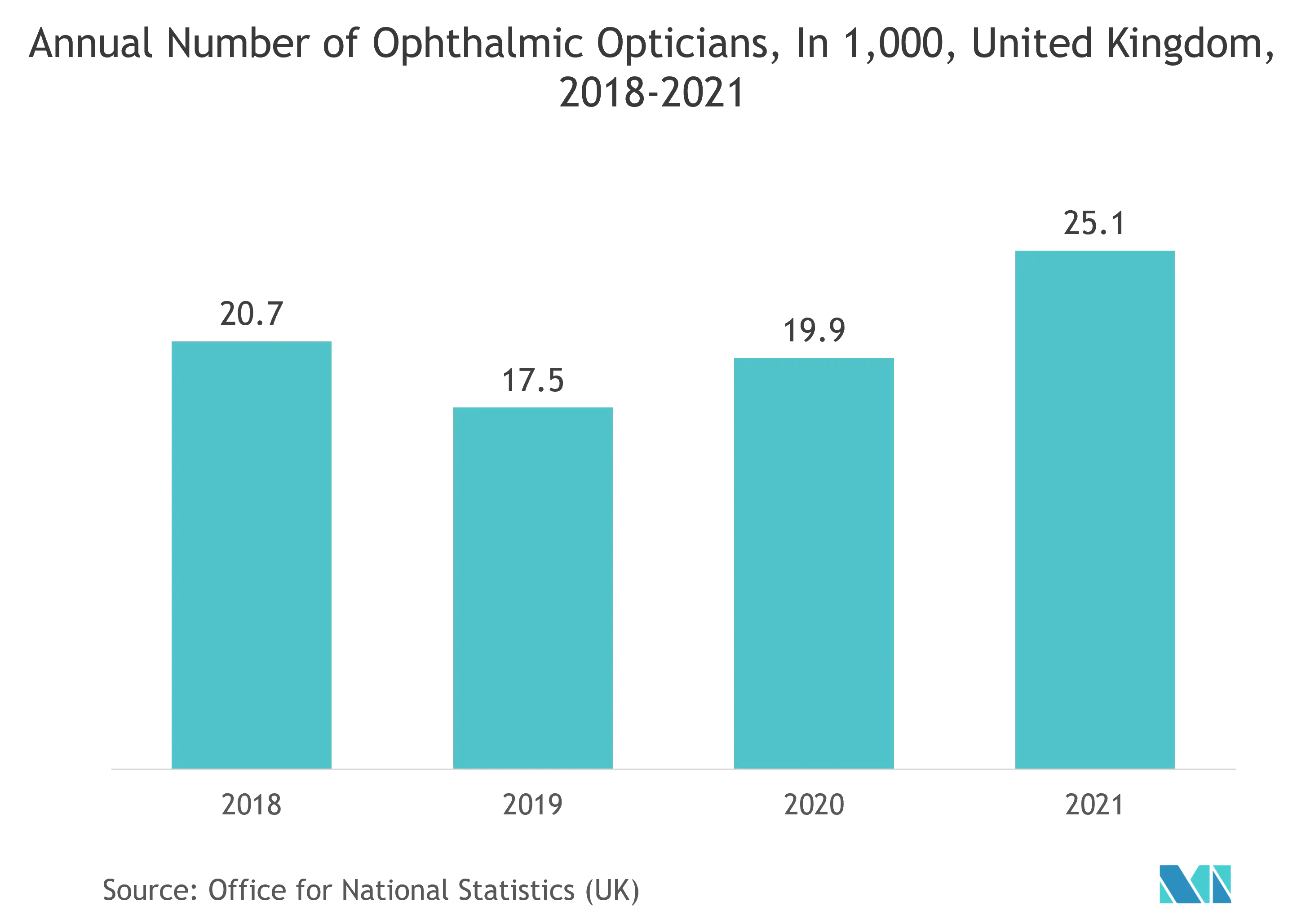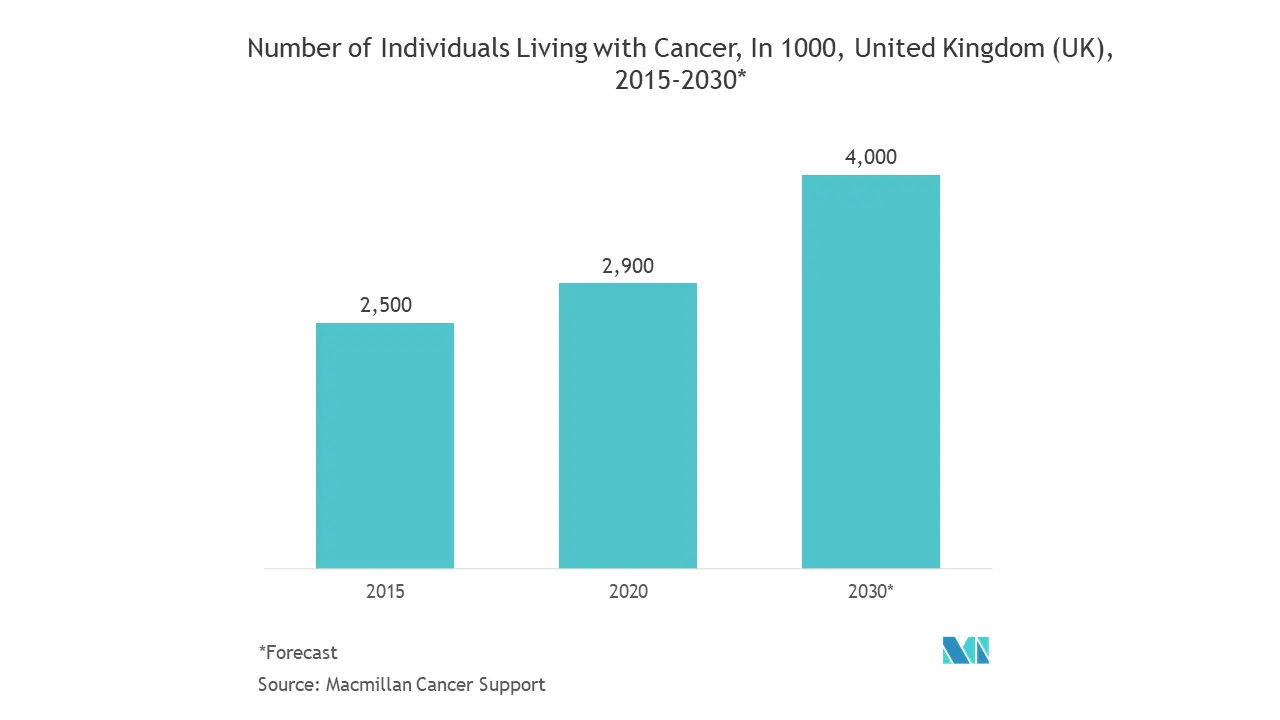Market Trends of Europe Optical Imaging Industry
This section covers the major market trends shaping the Europe Optical Imaging Market according to our research experts:
Ophthalmology Segment is Expected to Hold a Major Market Share
- The rising popularity of Optical Coherence Tomography, a non-invasive imaging technology used to obtain high-resolution cross-sectional images of the retina, and the growing prevalence of eye disorders, owing to the rising global geriatric population, is expected to aid the growth of the studied market.
- According to the Office for National Statistics (UK), there will be approximately 25.1 thousand ophthalmic opticians in employment in the United Kingdom (UK) in 2021, and the number is expected to rise in the near future. This can be attributed to the growing ophthalmic concerns in the region.
- Further, the construction of portable, handheld, Optical coherence tomography (OCT) devices could increase the ease of access and expand OCT into settings where use is currently prohibited by its cost and size. For instance, Envisu C2300 OCT, a handheld OCT solution intended to aid in the diagnosis of physiological and pathologic conditions of the eye, was developed by Leica Microsystems, Germany. It features full 3D volumetric data capturing capability with completely customizable high-density data scans up to 1000 x 1000 and is suitable for even premature infants.
- Also, the ophthalmic industry is witnessing an increasing integration of AI into diagnostic techniques. Artificial intelligence (AI), inspired by the human multilayered neuronal system, has shown significant improvements within some visual and auditory recognition tasks. AI can examine digital data in various tasks comprehensively, quickly, and non-invasive manner.
- The Europen region is witnessing AI-centric collaborations of companies to advance Ophthalmology research. For instance, in December 2020, RetinAI announced a multi-year collaboration with Novartis Pharma to deploy RetinAI’s IT solutions and artificial intelligence tools to support multiple projects in ophthalmology and digital health. The first initiative would fund a multi-center international clinical study including patients suffering from neovascular age-related macular degeneration (nAMD). The study is devised to investigate the influence of optical coherence tomography (OCT) image solutions using Artificial Intelligence (AI) on the assessment of disease activity. The study would be conducted in several clinical centers in numerous European countries and Canada, involving more than 500 patients.

Optical Imaging in Oncology is Expected to Witness Significant Growth
- Head and neck cancers have become a severe threat to human health nowadays. While surgery remains the first-line choice for head and neck cancer patients, the limited resectable tissue mass and complex anatomy structures in the head and neck region put the surgeons in a dilemma between extensive resection and a better quality of life for the patients because, if too much is removed, it might negatively impact the patient’s quality of life, and if too little is removed, cancer would likely reoccur.
- Early diagnosis and treatment of the pre-malignancies, and real-time in vivo detection of surgical margins during en bloc resection, could be leveraged to minimize the resection of normal tissues.
- Recent advancements in optical hardware and reagents have created new prospects for real-time pre-malignancy and cancer imaging in the clinic or operating room. Optical imaging in the head and neck has been reported using autofluorescence imaging, targeted fluorescence imaging, high-resolution microendoscopy, narrow-band imaging, and Raman spectroscopy.
- Further, a European research team based across Germany, the UK, Denmark, Ireland, and Austria is developing a new optical imaging platform that uses harmless light beams to spot the tell-tale signs of colon cancer at an incredibly early stage. Instead of inserting a typical camera into the intestine and then performing surgery to remove a growth for examination and analysis, this novel optical imaging approach can help clinicians avoid unnecessary invasive biopsy by enabling them to view the tissue in much greater detail.
- Calling themselves PROSCOPE, the consortium targets to save up to half of the 160,000 lives lost annually in Europe to CRC. The PROSCOPE project, which would conclude in 2024, would perform subsequent trials in clinics at the Medical University of Vienna. The four-year PROSCOPE project received a grant of EUR 5,999,383.75 from Horizon 2020 under the Research and Innovation action funding schemes. Initiatives like the PROSCOPE, which aim to innovate non-invasive procedures for the early detection of cancer, are expected to drive the studied market in the European region.


